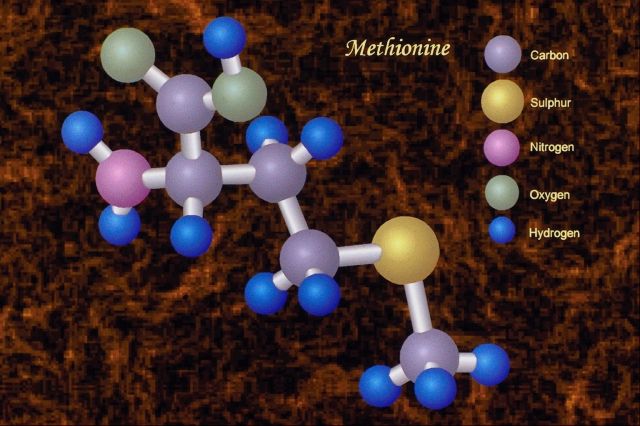
● Is produced when a newly formed polypeptide chain coils and folds spontaneously, mostly in response to hydrophobic interactions.
● Is stabilized by chemical bonds between neighboring regions of the folded protein.
D. Levels of Protein Structure
The correlation between form and function in proteins is an emergent property resulting from superimposed levels of protein structure:
1. Primary structure.
2. Secondary structure.
3. Tertiary structure.
When a protein has two or more polypeptide chains, it also has:
4. Quaternary structure.
1. Primary Structure
Primary structure = Unique sequence of amino acids in a protein.
● Determined by genes.
● Slight change can affect a protein's conformation and function (e.g. sickle-cell hemoglobin)
● Can be sequenced in the laboratory. A pioneer in this work was Frederick Sanger who determined the amino acid sequence of insulin (late 1940's and early 1950's). This laborious process involved:
a. Determination of amino acid composition by complete acid hydrolysis of peptide bonds and separation of resulting amino acids by chromatography. Using these techniques, Sanger identified the amino acids and determined the relative proportion of each.
a. Alpha (a) Helix
Alpha (a) helix = Secondary structure of a polypeptide that is a helical coil stabilized by hydrogen bonding between every fourth peptide bond (3.6 amino acids per turn).
● Described by Linus Pauling and Robert Corey in 1951.
● Found in fibrous proteins (e.g. a-keratin and collagen) for most of their length and in some portions of globular proteins.
b. Beta (b) Pleated Sheet
Beta (b ) pleated sheet = Secondary protein structure which is a sheet of aiitiparallel chains folded into accordion pleats.
● Held together by interchain hydrogen bonds.
● Make up the dense core of many globular proteins (e.g. lysozyme) and the major portion of some fibrous proteins (e.g. fibroin, the structural protein of silk).
3. Tertiary Structure
Tertiary structure = Irregular contortions of a protein due to bonding between side chains (R groups); third level of protein structure superimposed upon primary and secondary structure.
Types of bonds contributing to tertiary structure are weak interactions and covalent linkage (both may occur in the same protein).
a. Weak Interactions
Protein shape is stabilized by the cumulative effect of weak interactions. These weak interactions include:
● Hydrogen bonding between polar side chains.
● Ionic bonds between charged side chains.
● Hydrophobic interactions between nonpolar side chains in protein's interior.
Hvdrophobic interactions = (Hydro = water; phobos = fear) The clustering of hydrophobic molecules or hydrophobic portions of molecules as a result of their mutual exclusion from water.
b. Covalent Linkage
Disulfide bridges form between amino acids like cys monomers brought together by folding the protein. This is a strong bond that reinforces conformation. 4. Quaternary structure- structure that results from the interaction among several polypeptides in a single protein. Examples are collagen and hemoglobin. E. Factors Determining Conformation- If a proteins environment is changed it may lose its native conformation. Denaturation- a process that alters a protein's native conformation and biological activity. Proteins can be denatured by. 1) transfer to an organic solvent 2) chemical agents that disrupt hydrogen bonds, ionic bonds,and disulfide bonds. These agents could be acids or bases. 3) excessive heat. Some denaturation is reversible others are not (remember that egg) I am going to show you a transparency about how protein structrue is determined and talk about the importance of Chaperonin proteins - you got to love that name. You will just have to take a few notes O.K. Good Night Moon!http://users.rcn.com/jkimball.ma.ultranet/BiologyPages/D/DenaturingProtein.html